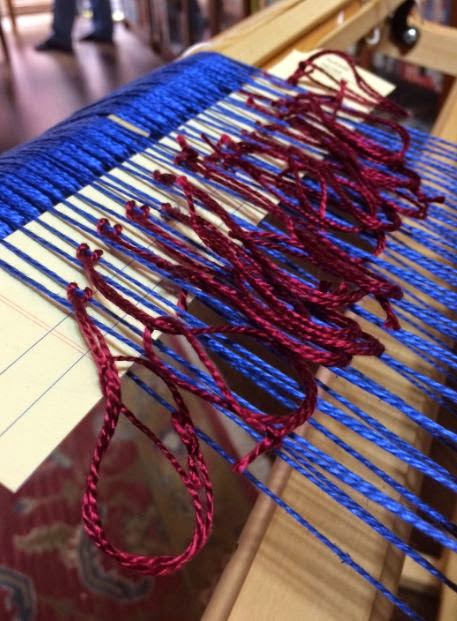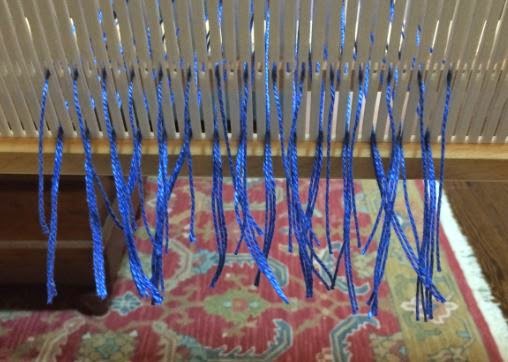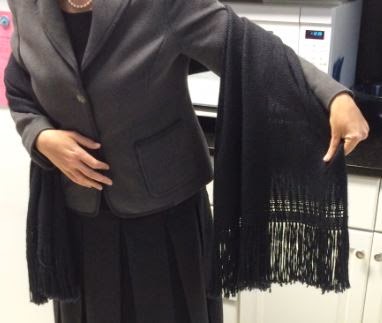It is definitely possible (and quite straightforward) to do a 1/3 twill on a rigid heddle loom using 2 heddles, a pick up stick, and a set of string heddles (or second pick up stick). I say "quite straightforward" after I did what I should have done from the beginning - - consulted a book. Jane Patrick's excellent The Weaver's Idea Book has a clear and detailed explanation of how to weave 1/3 twill on a rigid heddle loom. Alas, Patrick's book was the second one I consulted - - the first was David Xenakis' The Xenakis Technique, which I have yet to understand in even the tiniest way. Others have raved about this book, but I just cannot parse it at all for some reason. Not only did I feel stupid for not understanding this book, I only confused myself beyond all understanding, getting more and more frustrated in the process.
The Xenakis book was no help, and a review of several blog posts and message boards about twill only confused me to the point that I was ready to scrap the entire project. I tried a couple of different ways to thread my heddle, but without a clear idea of the treadling sequence, I was really just fumbling around in the dark. Completely ineffectually, I might add.
I decided to sleep on things and in the meantime my partner the Nerd tried a new version of a 1/3 twill using the Xenakis book (which he understands much more than me). He had long floats in his work from his fourth warp thread in each series, but there was definitely a twill pattern there, which gave me hope. Reinvigorated, I picked up the Patrick book (which I should have done at the beginning), and sure enough, on page 191 were detailed instructions for tying up a 1/3 twill, complete with full treadling instructions.
Here's where the simple stuff comes in. Patrick has a nice clear drawing for how the two heddles should be threaded. My only complaint is that her drawing is upside down to me, since I thread my back heddle first. Here is the threading sequence seen from the front looking back (rather than from the back looking front, as in Patrick's book):
Working from left to right across the rear heddle thread #1 goes in a slot, and thread #2 goes into the hole immediately to the right. Threads #3 and #4 both go in the next slot immediately to the right. The next hold is skipped, and then the pattern repeats across the reed, with the next thread being placed in the first slot to the right of the skipped hole.
For the front heddle, the first three threads (from the first slot (#1), the hole (#2), and the left-most thread of the second slot (#3)) all go into the slot directly under the slot with the double threads on the rear heddle, as shown above. The right-hand thread from the second slot (thread #4) goes into the hole to the right of the 3 threads just placed. The next slot and hole are then skipped, and the pattern repeats again.
Here's how the rear heddle looked on my loom:
And here's how the front heddle looked:
All together now:
Placing the first pick up stick was simple. I placed both heddles in the down position, then picked up the left thread of each pair, alternating 1 up x 1 down across the reed.
 Patrick recommends using a string heddle rather than a second pick up stick for the 1/3 twill, so that's what I did for this sampler. You can see the strings for the heddle in place (without the stick). For this sample I attached the string heddle to the right thread in each pair, that is, the thread not already picked up by my first pick up stick.
Patrick recommends using a string heddle rather than a second pick up stick for the 1/3 twill, so that's what I did for this sampler. You can see the strings for the heddle in place (without the stick). For this sample I attached the string heddle to the right thread in each pair, that is, the thread not already picked up by my first pick up stick.It was a very simple matter to attach the string heddles to a length of dowel cut for the purpose. This photo is somewhat misleading as I actually moved my pick up stick to behind the string heddles before I started weaving, but this photo clearly shows how the string heddles and the pick up stick lift alternating warp threads.
[If I were some bloggers, this is where I would stop, leaving the whole treadling sequence as some elaborate mystery. Elaborate mysteries suck, though, so I'm not going to do that.]
Ironically enough the Nerd and I stumbled across the proper treadling sequence in our trial and error efforts, we just didn't know it. Patrick confirms that the proper sequence is:
Row 1: front heddle up
Row 2: heddles in neutral, pick up stick [A]
Row 3: back heddle up
Row 4: heddles in neutral, string heddles / pick up stick [B]
And that's all it takes (!). This produces a 1/3 twill with weft floats that appear to move diagonally up and to the right, as shown in the bottom portion of the photo below.
It's just as simple to reverse the direction of the twill by reversing the above sequence:
Row 1: heddles in neutral, string heddles / pick up stick [B]
Row 2: back heddle up
Row 3: heddles in neutral, pick up stick [A]
Row 4: front heddle up
This produces weft floats that appear to move diagonally up and to the left, as shown in the middle portion of the photo below.
For this sampler I finished off with a simple basketweave that is made by simply weaving up and down with the front heddle only. This produced a very dense, horizontal weave as shown in the top portion of the photo above.
The pattern can also be seen on the reverse of the work:






















































